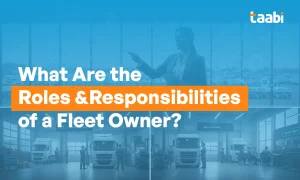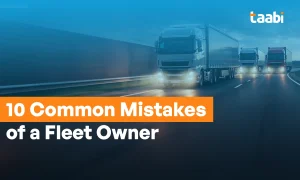Taabi Analytics for Continuous Improvement: Taabi’s analytics capabilities give fleet managers valuable insights into fleet performance metrics such as fuel consumption, driver behaviour and vehicle utilisation. Leveraging this data, managers can use Taabi to identify areas for improvement, such as driver training programs or optimising fleet utilisation to achieve increased efficiency and cost savings.
Introduce Taabi Products: This blog post shows how Taabi’s advanced fleet management solutions can address fleet managers’ unique challenges while unlocking significant cost savings. Taabi’s predictive maintenance module, real-time tracking and optimisation features, performance analytics capabilities, and remote diagnostics functionality effectively increase fleet uptime while decreasing expenses.
Fleet Management Cost Analysis: Fleet cost analysis is one of the most vital tasks available to an owner-operator. It provides insight into the actual operating expenses for your vehicles, which directly affects your bottom line and overall business operations.
This article was based upon survey findings and majority conclusions. Do You Want to Maximise Fleet Management Results and Cut the Amount of Fuel wasted? Taabi is a leading provider of cutting-edge technologies for managing fleets to enhance efficiency while reducing costs. Taabi’s sophisticated monitoring capabilities provide instant insight into fuel consumption for fleet management purposes – monitor levels, identify poor-performing vehicles, and then take preventative actions against the waste of precious oil.
A simple dashboard provides an easy-to-read usage overview, allowing for informed decision-making, and fuel-saving strategies may be implemented effectively and efficiently. Taabi’s ability to save on fuel and uptime helps companies cut costs. A lower breakdown rate means greater savings.
Total Cost of Ownership (TCO) analysis provides businesses with an effective tool to compare various purchasing options by considering both their purchase price and operational expenses.
Companies and individuals use the total cost of ownership analyses (TCO) in numerous situations involving major purchases, including vehicles and homes. TCO analysis also serves as a useful tool for gauging long-term benefits while avoiding hidden expenses in the future.
TCO analyses generally expose all costs related to an asset from its inception through disposal or resale, from initial purchase through life cycle costs such as operating expenses (such as wages or overhead costs) as well as capital expenses booked as line items in financial statements and some instances, indirect expenditures.
TCO analysis can be an invaluable decision-making aid and is key to expense optimisation. By considering TCO when making procurement choices, decision-makers can ensure their procurement choices are based on value rather than immediate purchase price alone, helping prevent future losses by choosing value-driven procurement alternatives versus those offering the lowest bid price alone. TCO can level the playing field when bidding competitions occur where lower prices may not necessarily represent the most economical choices.
A TCO analysis is an evaluation method encompassing acquisition and operating costs for products, systems or equipment. It can help reveal obvious and hidden expenses to select the ideal product for your facility – enterprise hardware or company vehicles – and reveal any added income your purchase brings your business.
A thorough TCO analysis encompasses all costs related to owning and using an asset over its lifespan, not just its initial purchase cost. These expenses usually include ongoing maintenance or repair expenses; energy costs related to running it; taxes related to ownership; projection of value retention to help estimate resale or residual values at the end of its useful life; as well as forecasts on projected resale or residual values upon end-of-life sales or service contracts.
The length of an ownership life included in a total cost analysis depends on several variables, including an analyst’s subjective decision and the type of asset being evaluated.
Analysts usually select the longest ownership period possible when conducting TCO analyses, depending on the purpose of this exercise. Estimation sources could include industry standards, published TCO analyses from other analysts or publishing consultants, vendor recommendations or experience, project plans to utilise an asset, cost trends due to inflation, price changes, customer demand or technology advances or government regulations and costs that fluctuate with inflation; inflation; technology innovations or government regulation trends and cost trends due to inflation; price changes or customer demands for using assets etc. A typical tco model features rows and columns representing various resource items whose ownership costs impact ownership costs with potential costs listed costs listed per cell expressing resource items etc.
The total cost of ownership calculators is an effective tool to streamline expenses. They consider all direct and indirect charges related to products or services from their lifecycle, which helps compare alternatives and determine which provides greater value for money.
Buyers tend to focus on initial price tags when making decisions and neglect to consider any unforeseen additional expenses that may come up over time. A business looking to upgrade its server system could investigate all available options on the market and assess its total cost of ownership (TCO). One option could have a lower initial purchase price but require costly upgrades in future or require expensive team training over time, while another might require less maintenance and be more budget-friendly over time.
TCO considers all the financing conditions necessary to make any purchase possible, such as down payments, interest rates and loan length. Each will have an impactful result on annual costs as well as overall costs over its lifespan.
For example, consider two vehicles A and B, with equal initial purchase prices. Yet, one requires much higher ongoing operating costs due to higher fuel consumption, more maintenance needs, and a shorter lifespan. Vehicle B offers greater fuel efficiency, allowing it to run longer without refilling its gas tank.
TCO analysis seeks to reveal all of the lifetime costs that arise from owning certain assets, both those that are obvious before purchase and those which may be easy to overlook during acquisition. TCO can be used to assess the viability of capital investments, product comparison, and supplier assessment.
Different TCO models exist for various contexts and industries. Gartner developed one tailored to IT infrastructure based on full cost accounting principles and ecological and economic concepts. But in general, TCO estimates the expenses incurred by products or services from their point of purchase until they are removed from inventory or retired altogether.
TCO (total cost of ownership) analysis allows businesses to measure all associated and indirect expenses related to an investment, such as maintenance, training, and downtime due to equipment failure. This will enable them to understand an investment’s impact and find ways to save money over time.
TCO analysis effectively evaluates business deals and purchases, helping managers make smarter organisational decisions.
To Calculate TCO, you must Locate and Categorize Costs: Determine all associated with owning and operating a fleet vehicle, such as acquisition costs, fuel expenses, maintenance and repair expenses, registration/licensing fees, depreciation and administrative costs. Group these into categories.
Collect Data: Gather accurate and detailed data related to each cost category by reviewing invoices, receipts, fuel consumption records, maintenance logs, insurance policies and any other pertinent documents.
Calculate Your TCO: Once your fleet data are in hand, use them to calculate TCO per vehicle by totalling all associated expenses within a specific period. Include purchase price, financing costs, fuel expenses, maintenance repair bills, premium payments for insurance policies, and operational expenses when doing so.
Analyse Total Cost of Ownership: When reviewing TCO figures across your fleet vehicles, look for patterns or trends; identify vehicles whose costs appear disproportionate to the performance/usage ratio; this analysis can reveal areas for cost optimisation opportunities.
Determine Optimization Opportunities: From your analysis, identify specific areas where cost optimisation might be possible – for instance.
Fuel Efficiency: Search out vehicles with higher fuel consumption rates, and consider replacing them with more economical models that use fuel more efficiently.
Maintenance and repairs: Recognizing vehicles requiring frequent and expensive repairs; exploring preventive maintenance measures for those vehicles, and possible contract/negotiated rates with service providers are key steps in protecting fleet assets from costly breakdowns and repairs.
Review Insurance Plans and Shop for Better Rates or Explore Cost Saving Options with Fleet Coverage: Conduct an in-depth examination of all existing policies to find more competitive premiums or consider any available fleet coverage that might provide cost savings opportunities.
Vehicle Life Cycle: Analyse each vehicle in your fleet carefully to ascertain its optimal lifecycle, noting when its maintenance costs outweigh its benefits; replace or retire those cars accordingly.
Implement Optimization Strategies: Using your analysis and identify opportunities, devise strategies to minimise costs. This may involve purchasing more fuel-efficient vehicles, negotiating favourable maintenance contracts, researching alternative fuel options, offering driver training programs to increase fuel efficiency while decreasing wear-and-tear damage and installing fleet management software to track and control expenses more effectively.
Maintain and Evaluate: Regularly assess and monitor the Total Cost of Owning (TCO) of your fleet vehicle fleet. Update data as necessary, track cost-cutting initiatives and evaluate their effects before making necessary adjustments for optimal ongoing optimisation.
Remember that TCO optimisation is an ongoing process requiring analysis, monitoring and adjustments over time to produce desired results.
Taabi can collect data about the costs of running your fleet. Taabi will automate data gathering for such factors as fuel usage, maintenance records and repair bills, insurance premiums, licensing/registration fees, and any additional relevant expenses.
Data Input to Taabi: Add information collected into Taabi software using its straightforward user interface for inputting and organizing information for analysis.
Taabi’s TCO Analysis Tools: Take advantage of Taabi’s TCO tools to analyse and determine the cost associated with each vehicle in your fleet. Taabi offers reports and visualisations to give an in-depth analysis of costs related to everyone.
Unleash Cost Saving Opportunities: Taabi provides TCO analysis which allows you to identify areas with potential cost reduction opportunities, assisting in identifying vehicles that incur high operating expenses or require high fuel consumption levels.
Use Taabi’s optimisation capabilities to take cost-cutting strategies. Taabi provides features like monitoring fuel efficiency, maintenance schedules, driver behaviour analysis and routing optimisation that can be utilised to reduce costs while improving fleet efficiency and optimising fuel usage.
Analyse Effects: Evaluate and monitor the implementation and results of Taabi cost optimisation strategies regularly to assess their efficacy in meeting savings goals. Taabi offers real-time information to keep an eye on the progress of efforts being implemented through Taabi; use data from Taabi reports as evidence that these savings strategies have produced expected cost-cutting gains.
Taabi can assist you with optimising cost optimisation strategies by offering analysis and feedback of their analysis on areas for potential improvements, such as driver training programs, vehicle replacement costs, and even renegotiating insurance contracts.
Taabi provides a tool for tracking the total cost of ownership (TCO) for your fleet’s expenses and performance over time. Taabi’s reporting and analytics features can assist with keeping an eye on fleet costs over time and improving long-term efficiency.
Taabi features and data-analysis capabilities allow for easier TCO calculations and informed decisions to optimise cost for your vehicle.








